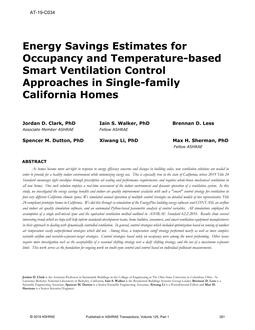Click here to purchase
As homes become more air-tight in response to energy efficiency concerns and changes in building codes, new ventilation solutions are needed inorder to provide for a healthy indoor environment while minimizing energy use. This is especially true in the state of California, whose 2019 Title 24Standard encourages tight envelopes through prescriptive air sealing and performance requirements, and requires whole-house mechanical ventilation inall new homes. One such solution employs a real-time assessment of the indoor environment and dynamic operation of a ventilation system. In thisstudy, we investigated the energy savings benefits and indoor air quality improvement available with such a “smart” control strategy for ventilation infour very different California climate zones. We simulated annual operation of multiple control strategies on detailed models of two representative Title24-compliant prototype homes in California. We did this through co-simulation of the EnergyPlus building energy software and CONTAM, an airflowand indoor air quality simulation software, and an automated Python-based parametric analysis of control variables. All simulations employed theassumption of a single well-mixed zone and the equivalent ventilation method outlined in ASHRAE Standard 62.2-2016. Results show severalinteresting trends which we hope will help inform standards-development teams, home builders, consumers, and smart ventilation equipment manufacturersin their approach to dealing with dynamically controlled ventilation. In general, control strategies which included optimization based on sensing of outdoorair temperature vastly outperformed strategies which did not. Among these, a temperature cutoff strategy performed nearly as well as more complexvariable airflow and variable-exposure-target strategies. Control strategies based solely on occupancy were among the worst performing. Other issuesrequire more investigation such as the acceptability of a seasonal shifting strategy over a daily shifting strategy, and the use of a maximum exposurelimit. This work serves as the foundation for ongoing work on multi-zone control and control based on individual pollutant measurements.
Citation: 2019 Winter Conference, Atlanta, GA, Conference Papers
Product Details
- Published:
- 2019
- Number of Pages:
- 8
- Units of Measure:
- Dual
- File Size:
- 1 file , 1.5 MB
- Product Code(s):
- D-AT-19-C034
